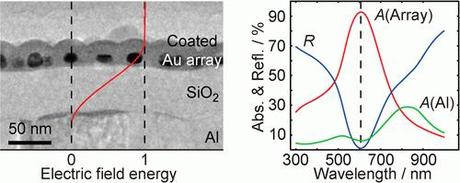 Stanford University Scientists have successfully developed the thinnest light absorber to ever exist. Their creation is thousands of times thinner than a sheet of common writing paper. The nano-sized light absorbing structures are engineered to absorb 100% light that's visible and from specific wavelengths.
Stanford University Scientists have successfully developed the thinnest light absorber to ever exist. Their creation is thousands of times thinner than a sheet of common writing paper. The nano-sized light absorbing structures are engineered to absorb 100% light that's visible and from specific wavelengths.The optimism around this discovery is that the material could be a stepping stone for processes that may reduce the price of solar cells, while making them more efficient at the same time.
 This awesome study was published in the current online edition of the journal Nano Letters. Carl Hägglund the lead author of the study in a statement said "much like a guitar string, which has a resonance frequency that changes when you tune it, metal particles have a resonance frequency that can be fine-tuned to absorb a particular wavelength of light,". "We tuned the optical properties of our system to maximize the light absorption." (reference)
This awesome study was published in the current online edition of the journal Nano Letters. Carl Hägglund the lead author of the study in a statement said "much like a guitar string, which has a resonance frequency that changes when you tune it, metal particles have a resonance frequency that can be fine-tuned to absorb a particular wavelength of light,". "We tuned the optical properties of our system to maximize the light absorption." (reference)The abstract for this research paper may shed more light to this story:
Block copolymer lithography and atomic layer deposition were combined to tune the effective optical properties of a plasmonic array at the atomic scale. Critical coupling to the resulting nanocomposite layer is accomplished through guidance by a simple analytical model and measurements by spectroscopic ellipsometry. Thereby, a maximized absorption of light exceeding 99% is accomplished, of which up to about 93% occurs in a volume-equivalent thickness of gold of only 1.6 nm. This corresponds to a record effective absorption coefficient of 1.7 × 107 cm–1 in the visible region, far exceeding those of solid metals, graphene, dye monolayers, and thin film solar cell materials. It is more than a factor of 2 higher than that previously obtained using a critically coupled dye J-aggregate, with a peak width exceeding the latter by 1 order of magnitude. These results thereby substantially push the limits for light harvesting in ultrathin, nanoengineered systems.
Original article source
Image sources top: Nano Letters Bottom: popsci
ENJOYED THIS POST? Subscribe and Like Us on Facebook or Google Plus! No Spam!
